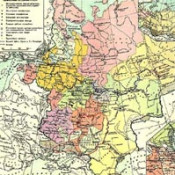
Senate approved Peter the Great’s decree on governorates’ administrative division
On May 29 (June 9) 1719 the Governing Senate adopted a decree by Peter the Great “On Governorates’ division and appointment of their governors”.
The country’s administrative division into governorates was introduced, when it became obvious that the old voyevodas’ management system could hardly deal with the new historical aims.
By the decree of Peter I of December 18 (29) 1708 the territory of the Russian Empire was divided into 8 large governorates (Moscow, Ingria (Ingermanland) (since 1710 - St. Petersburg), Arkhangelgorod, Kiev, Smolensk, Kazan, Azov, Siberia). Each province included uezds, established in 17th c., which were headed by voyevodas, who in 1710 were renamed commandants.
Peter the Great’s administrative reform of May 29 (June 9) 1719 was aimed at division of large territories into smaller ones. From now on all the governorates except for Astrakhan and Revel, were divided into smaller units — provinces. Firstly there were 45 provinces, later this number increased to 50.
The St. Petersburg governorate included 11 provinces: St. Petersburg, Vyborg, Narva, Revel (later was reorganized into a governorate), Velikie Luki, Novgorod, Pskov, Tver, Yaroslavl, Uglich, and Belozersk.
The Moscow governorate was made out of 9 provinces: Moscow, Pereyaslavl-Ryazansky, Kostroma, Suzdal, Yuriev-Polsky, Vladimir, Pereyaslavl-Zalessky, Tula and Kaluga.
The Kiev governorate contained 4 provinces: Belgorod, Sevsk, Oryol and Kiev.
The Azov governorate was divided into 5: Voronezh, Yelets, Tambov, Shatsk and Bakhmutsk.
The Riga governorate split into 2 provinces: Riga and Smolensk.
The Arkhangelgorod governorate was separated into 4 provinces: Dvinsk, Vologda, Ustyug and Galich.
The Siberia governorate included 3 provinces: Vyatka, Solikamsk and Siberian towns, totaling 19, from Tobolsk to Yakutsk.
There were 4 provinces in the Kazan governorate: Kazan, Sviyazhsk, Penza and Ufa.
Three provinces were represented in the Nizhny Novgorod governorate: Nizhny Novgorod, Samara and Alatyr.
The Astrakhan governorate was made out of all the towns on the Lower Volga, from Simbirsk to Astrakhan.
Important provinces were headed by General Governors, whereas voyevodas were in charge of the rest provinces. Provinces were divided into okrugs — districts, headed by zemsky commissars, elected out of local nobility.
In 1727 districts were abolished and a historical administrative division into uezds was revived.
Lit.: Межуев Б. Генерал-губернаторство в системе местного управления России [Электронный ресурс] // Русский архипелаг. 2014. URL: http://www.archipelag.ru/geoeconomics/kapital/system/local/; Милюков П. Н. Государственной хозяйство России в первой половине XVIII столетия и реформы Петра Великого. М., 1984; Тархов С. А. Историческая эволюция административно-территориального и политического деления России // Регионализация и развитие России: географические процессы и проблемы. М., 2001. С. 191-213; То же [Электронный ресурс]. URL: http://www.demoscope.ru/weekly/2003/0101/analit04.php.
Based on the Presidential Library’s materials:
Административно-территориальное деление // Территория России: [цифровая коллекция];
Богословский М. М. Областная реформа Петра Великого: провинция 1719-27 гг. М., 1902;
Полное собрание законов Российской империи. СПб., 1830. Т. 5. № 3380. С. 701.

